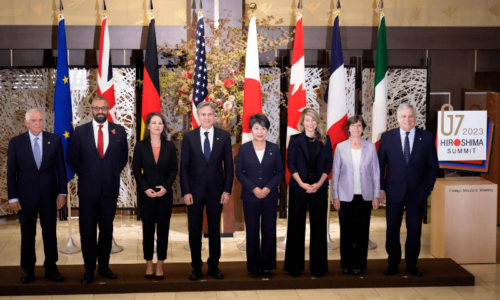By Qamar Bashir
The government, people, and political elite of Pakistan seem largely unaware that the
Russia-Ukraine war is taking a dangerous turn as the G-7, a powerful coalition of the
world's wealthiest and most resourceful countries, is currently meeting in Italy (13-15
June, 2024) and while enjoying Italy's legendary hospitality, they have taken the decision
to allow Ukraine to use U.S. and Western arms, ammunition, drones, robots, missiles, and
other weaponry to launch attacks within Russia.
G-7 countries (Canada, France, Germany, Italy, Japan, the United Kingdom, and the
United States) on a glass of wine has also decided to unfreeze Russian assets amounting
to US$ 50 Billion mainly parked in Europe and other parts of the world, which were
frozen following Russia's invasion of Ukraine to fund Ukraine's war efforts, including
repaying the U.S. and other Western countries that have been supplying weapons and
military support to Ukraine.
These vital and highly sensitive and critical decisions are akin to poking Russia to react
violently and take desperate and drastic actions to counter these moves and protect its
interests.
Russia may intensify military operations in Ukraine, launching large-scale offensives
targeting major cities and critical infrastructure. Additionally, Russia might employ its
sophisticated cyber warfare capabilities to launch widespread cyber attacks against
critical infrastructure in Ukraine, the US, and Europe, disrupting power grids, financial
systems, communication networks, and other essential services.
It could also use tactical nuclear weapons on the battlefield in Ukraine to force a swift
and decisive victory, though this would have catastrophic consequences and likely
provoke a massive international response.
It may target Western supply lines and logistics hubs in NATO countries providing
military aid to Ukraine, using missile strikes or sabotage to disrupt the flow of weapons
and supplies and targeting NATO allies in Eastern Europe, such as Poland or the Baltic
states to escalate the conflict to a broader regional war.
Beyond direct military actions, Russia could engage in economic warfare by cutting off
energy supplies to Europe, shutting down pipelines, or disrupting energy exports,
severely impacting European countries dependent on Russian energy. Covert operations
and proxy warfare could also increase, with Russia supporting insurgent or terrorist
groups within Europe and the US to create instability.
Diplomatic and political moves might involve strengthening alliances with countries
opposed to US and European policies, such as China, North Korea and Iran, forming new
economic or military alliances to counterbalance NATO and the G-7.
If Russia implemented its strategy and US and Europe may respond with a
comprehensive and coordinated approach by bolstering their military presence in Eastern
Europe, deploying additional troops and equipment, and increasing direct support to
Ukraine with advanced weaponry and intelligence.
They may impose economic sanctions targeting key sectors of the Russian economy,
such as energy and finance, and cyber countermeasures to strengthen defenses and
retaliate against Russian attacks.
Diplomatically, they would isolate Russia internationally, rallying condemnation through
forums like the UN and strengthening alliances with countries opposed to Russian
actions.
Each of these actions carries significant risks and could lead to unpredictable and
potentially catastrophic consequences, requiring careful international responses to avoid a
broader and more devastating conflict. Moreover, the implementation of Russia's
aggressive strategy and NATO's counter-strategy would severely impact weaker
economies like Pakistan.
Disruptions in Russian energy supplies to Europe would cause global energy prices to
soar. Pakistan, heavily reliant on energy imports, would face drastically increased fuel
and electricity costs, straining its economy. This surge would lead to higher
transportation, manufacturing, and household energy expenses, exacerbating inflation and
reducing disposable income for its citizens.
The conflict would likely disrupt global supply chains, affecting shipping routes and
logistics networks. Pakistan, which depends on imports for essential goods and raw
materials, would experience delays and increased costs. This disruption could lead to
shortages of critical items, higher import prices, and further inflation, negatively
impacting both consumers and businesses.
Financial markets would experience significant volatility, with investors seeking safer
assets amid the uncertainty. This could result in capital outflows from emerging markets
like Pakistan, causing the Pakistani rupee to depreciate. A weaker currency would make
imports more expensive, further fueling inflation and increasing the cost of servicing
external debt, straining Pakistan's financial stability.
Amid global economic instability, foreign direct investment (FDI) in weaker economies
would likely decline as investors become more risk-averse. Reduced FDI would hinder
economic growth and development projects in Pakistan, exacerbating unemployment and
slowing down infrastructure and industrial development.
International aid and development funds might be redirected to address the humanitarian
and economic impacts of the conflict in Europe. Pakistan could see a reduction in
international assistance, leaving it with fewer resources to manage its economic
challenges.
The combined effects of rising energy prices, trade disruptions, financial instability,
reduced investment, and decreased aid would have severe socioeconomic impacts on
Pakistan. Higher inflation would erode purchasing power, leading to increased poverty
and social unrest. The government would face challenges in providing adequate public
services and maintaining social stability amid growing economic hardships.
To safeguard its interests and economy from the aftershocks of the Russian strategy and
NATO's counter-strategy, Pakistan should implement a comprehensive contingency plan.
This plan includes diversifying energy sources by investing in renewables and securing
LNG imports while enhancing energy efficiency. Trade resilience should be bolstered by
exploring new markets and supporting domestic production. Financial stability can be
achieved by building foreign exchange reserves, encouraging remittances, and managing
debt through restructuring and diverse borrowing. Attracting foreign investment through
investor-friendly policies and special economic zones, alongside boosting domestic
investment via public-private partnerships and local investor incentives, is crucial.
Strengthening social safety nets with cash transfer programs and subsidies, and enhancing
public services in healthcare, education, and employment are essential. Diplomatic efforts
should focus on regional alliances and international aid. Cybersecurity measures and
military preparedness must be prioritized to protect infrastructure and ensure national
security. A crisis management task force should coordinate and monitor the plan to
ensure effective implementation and adaptability.




